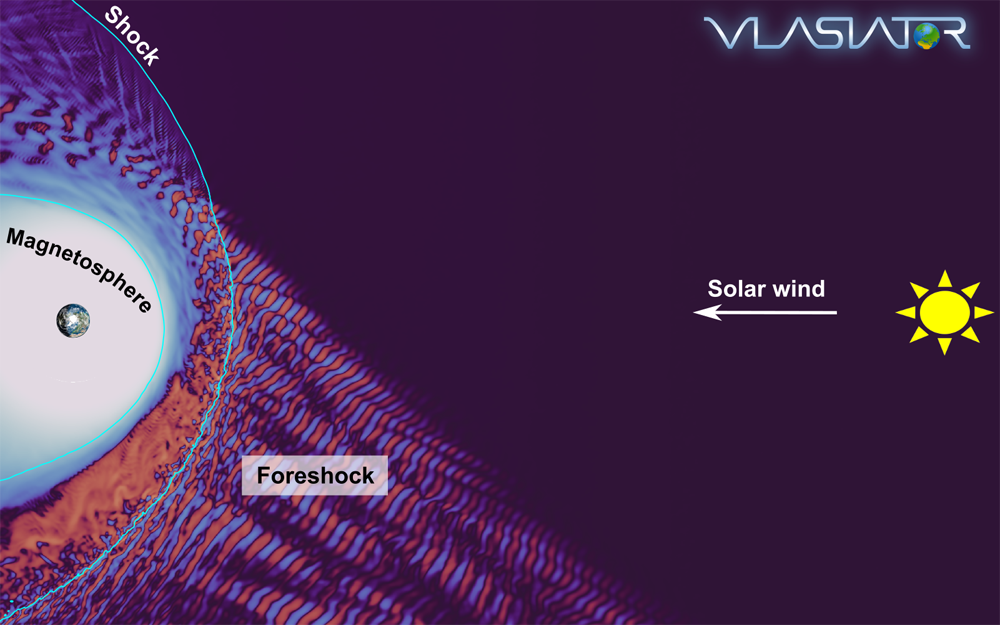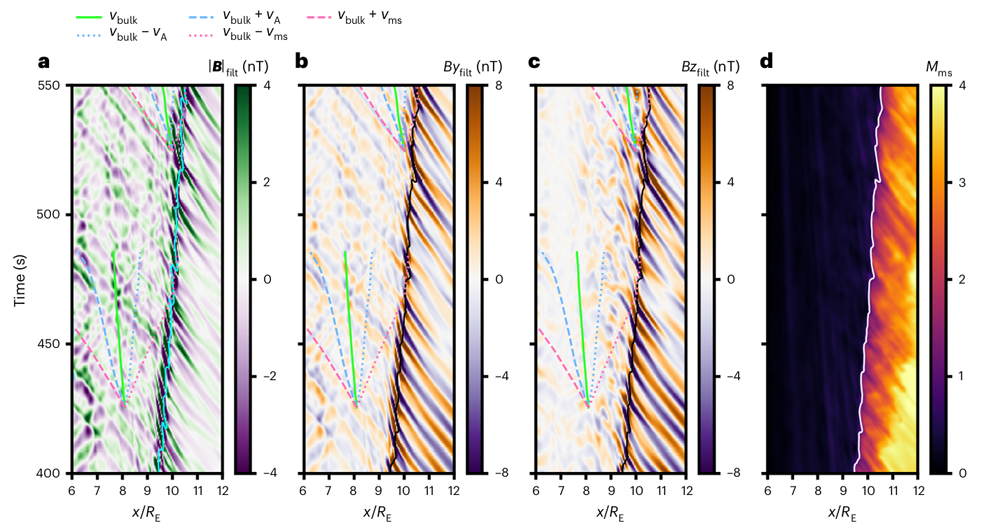This study makes use of state-of-the-art numerical simulations and spacecraft observations to investigate the processes at play when foreshock waves interact with Earth’s bow shock. Numerical simulations were performed with the Vlasiator model, developed at the University of Helsinki. The model describes foreshock waves in their global context and allows tracking the waves on their earthward journey. To confirm the numerical results, observations from the Magnetospheric Multiscale mission (MMS) were analysed upstream and downstream of Earth’s bow shock.
The results of the study show that the transmitted foreshock waves retain similar properties downstream of the shock as in the foreshock, and in particular their fast-magnetosonic nature – fast-magnetosonic waves are a class of plasma waves with correlated variations in plasma density and magnetic field strength. At first glance, it may seem that the waves traverse the shock unchanged, as predicted in early works. However, the direction of the wavevectors reverses across the shock, which is inconsistent with a direct transmission.

Figure 1: Overview of near-Earth space, as simulated by the Vlasiator model. The colour map shows the magnetic field north-south component, out of the plane of the simulation domain. The cyan lines indicate the bow shock and magnetopause positions. (Image Credit: L. Turc/The Vlasiator Team)
To understand the wave transmission, one needs to take a closer look at the processes happening when foreshock waves impinge on the shock. It was found that the waves modulate the plasma properties just upstream of the shock, and in particular the Mach number, which controls the shock strength. This results in a periodic variation of the compression of the plasma as it crosses the shock, which in turn creates regions of enhanced and decreased pressure in the downstream. This pressure imbalance launches compression and rarefaction waves, at the same period as the foreshock waves, which travel all the way to the magnetosphere.
This work provides the missing link in the transmission of foreshock waves from their source region upstream of the shock into the Earth’s magnetosphere, thus improving our understanding of near-Earth space dynamics. Solving this open question was one of the main goals of the ISSI Team #448, which gathered for this purpose experts of plasma waves in the different regions of near-Earth space.

Figure 2: Time-position maps of the (a) magnetic field strength, (b) magnetic field By component, (c) magnetic field Bz component and (d) magnetosonic Mach number, extracted from the simulation along the Sun-Earth line. The solid cyan, black and white lines indicate the bow shock position. The foreshock waves moving towards the shock appear as stripes of alternating colours on the right-hand side of panels a-c. Their counterparts in the downstream are visible in panels a-b. Panel d shows the modulation of the magnetosonic Mach number by the foreshock waves as they approach the shock. (Image Credit: L. Turc, published in Nat. Phys.)
Shocks, such as the bow shock forming ahead of Earth’s magnetosphere, are found everywhere in space, near other planets, supernovae remnants or active galactic nuclei, and are one of the main sources of high energy particles in our universe. Understanding how plasma waves interact with a bow shock, how they modify it and how they are transmitted to the other side of the shock brings us crucial new insight into collisionless shock waves in general.
Reference
Turc, O.W. Roberts, D. Verscharen, A.P. Dimmock, P. Kajdič, M. Palmroth, Y. Pfau-Kempf, A. Johlander, M. Dubart, E.K.J. Kilpua, J. Soucek, K. Takahashi, N. Takahashi, M. Battarbee, U. Ganse: Transmission of foreshock waves through Earth’s bow shock, Nature Physics, 2022, https://doi.org/10.1038/s41567-022-01837-z
Contact Lucile Turc (lucile.turc@helsinki.fi)



